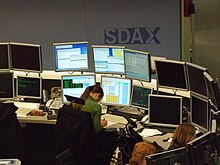
Back معاملهگری الکترونیکی Persian Trading Italian Электронная торговля Russian Tregtia elektronike Albanian Електронна торгівля Ukrainian

Electronic trading, sometimes called e-trading, is the buying and selling of stocks, bonds, foreign currencies, financial derivatives, cryptocurrencies, and other financial instruments online. This is typically done using electronic trading platforms where traders can place orders and have them executed at a trading venue such as a stock market either directly or via a broker.
Electronic trading first started in the 1970s but significant development occurred during the 1990s and again in the 2000s with the spread of the Internet. Electronic trading slowly replaced traditional floor trading and telephone trading over the following 20 years.[1]
Electronic trading can include various exchange-based systems that run the matching engine for orders, such as NASDAQ, NYSE Arca and Globex, as well as other types of trading platforms, such as electronic communication networks (ECNs), alternative trading systems, crossing networks and dark pools.[2][3] Electronic trading has also made it possible to do algorithmic trading where computers are used to place orders into the market often at high speed such as in high-frequency trading
- ^ Ian Salisbury and Geoffrey Rogow (September 25, 2008). "Gliches Cancel Electronic Trades". The Wall Street Journal. p. D3.
- ^ Lemke & Lins, Soft Dollars and Other Trading Activities, Chapter 2 (Thomson West, 2015-2016 ed.).
- ^ Jya, Wak (31 August 2016). "Different Types of Forex Trading Platforms, Which the Best ?". FXdailyReport.Com. Retrieved 29 October 2016.